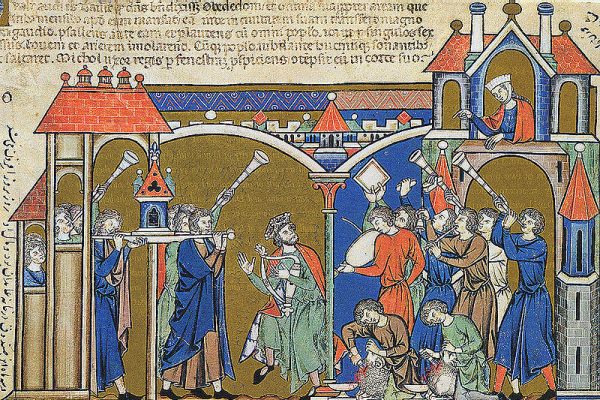Where is God for You?

The Bible records the story of the transfer of the Ark of the Covenant by King David from the city of Baale of Judah (also known as Kirjath-jearim or Abu Ghosh) to Jerusalem. One might be surprised to discover that this large chest, which played such a critical role in the wilderness wanderings of the people of Israel – said to contain the actual stone tablets on which the 10 Commandments were written along with Aaron‘s miraculous walking staff – wasn’t already in the King’s city! Hadn’t the people of God taken it everywhere with them? Indeed, the meandering path of the Ark (for a time it was even in the possession of Israel’s arch-enemy, the Philistines, where it was credited as the power behind all manner of mayhem) can serve as a marker of the uncentralized political structure among the people of God in the time between their arrival in Canaan and the establishment of a centralized monarchy under King Saul. In this light, we might interpret the story of the Ark’s transfer to Jerusalem as a sign of David consolidating his power in his new capital.
Though the Ark is long lost to us – the last mention of it in the Bible occurs in the context of it being installed in the temple Solomon had commissioned, after which it is never referred to again except by the prophet Jeremiah as a thing whose time has passed – the image of the Ark has fascinated Christians from a time long before Indiana Jones. Christian artists noted a symbolic link between the Ark as the container that held the word of God and the person of Mary, the mother of Jesus, whose womb harbored the living word of God. As we read the account in the First Book of Samuel, the description of the Ark parade and the dancing and celebrating King David might even trigger a connection for us to Jesus’ own celebratory entrance into the same city of Jerusalem. The Ark of the Covenant was for the people of its time the assurance of God’s attentive presence among them. It was the assurance of this attentive presence that David seemed to be seeking. Jesus’ entrance into Jerusalem trades on this image. The presence of God has come among the people, and the people celebrate God’s arrival.
What about us? Can we count on God’s attentive presence for us? How would we go about locating God? If Jesus has promised to be present wherever two or three people are gathered together in his name, do objects or places even matter anymore?
Martin Luther, the German theologian, anticipated this question when he was preaching on the occasion of the dedication of a new church. There he was, standing in its newly built pulpit – a pulpit that his good friend the artist Lucas Cranach had covered with lavishly-sculpted scenes from the Gospels – and Luther has the nerve to say, “Not that we’re making a special church out of it…one could just as well preach outside by the fountain or somewhere else.”1 Earlier in the same sermon, he declares that the reason such places are designated as churches is to give people in the community the assurance, in both place and time, of being able to hear the Gospel of God’s immeasurable and unconditional love for them in the forgiveness of sins and the promise of the resurrection.
That’s the central reason behind the place of the Chapel of the Resurrection at the center of our campus and the reason we schedule opportunities for worship and prayer eight times a week when classes are in session. It’s to give everyone the assurance that they know where they can go to hear the great news of the reality of immeasurable divine love for them and to receive the gifts of Jesus’ life and salvation.
Peace be with you.
– Pr. Jim
Oct. 18, 2023
Rev. Katherine Museus and Rev. James A. Wetzstein serve as university pastors at the Chapel of the Resurrection at Valparaiso University and take turns writing weekly devotions.
1 Luther, Martin, and Helmut T. Lehmann. “Sermon at the Dedication of Castle Church, Torgau 1544.” In Luther’s Works. 51: Sermons: 1, edited by John Doberstein, American ed., 333–54. Saint Louis, Mo.: Concordia Publ. House [u.a.], 1959. 337
- James Wetzstein
- The Wonder of Resurrection
- Forgiveness: The Necessary Miracle
- Everything Happens for a Reason or Does It?
- Of Groundhogs and Divine Love
- When You Pass Through the Fire…
- KHESED
- Psalm 46 – When There’s Trouble, God Can Always Be Located
- Who Are Your Beatitudes Mentors?
- The Posture of Gratefulness
- Like a Mirror of Eternal Truth
- “Light” and Other “L” Words
- Keeping Up with the Holy Spirit
- It’s a Three Day Weekend!
- Divine Love Can’t Quit You
- I Had a Bit of a Moment
- What to do When Our Resolutions Don’t Deliver
- Have Yourself a Merry Little Christmas (Somehow)
- Adventing in the Meantime
- Life and Death Collisions
- Imagining Eternity
- Where is God for You?
- All You Need Is Love, Love Is All You Need
- God Uses Crooked Sticks to Draw Straight Lines
- “Reset/Refresh” Sabbath as rest, not distraction